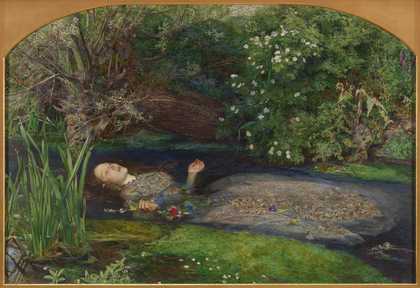
Sir John Everett Millais, BtOphelia 1851–2Tate
Beauty as Protest 1845–1905
16 rooms in Historic and Early Modern British Art
The men and women of the Pre-Raphaelite circle question mainstream Victorian culture and ideas
In 1848, revolutions all over Europe spread the spirit of reform across the continent. Three art students, Dante Gabriel Rossetti, John Everett Millais and William Holman Hunt, launch a revolution in art. Rossetti is the son of an Italian revolutionary. Hunt worked in a textile warehouse for the popular political activist, Richard Cobden. Hunt and Millais watch Chartist campaigners march on parliament to petition for workers’ rights. In November 1848, the trio create a radical artistic group called the Pre-Raphaelite Brotherhood.
The Pre-Raphaelites reject the academic art of the Royal Academy, which holds certain historical subjects and styles in high esteem. They look for authenticity in art of all periods, but seek relevance to their modern times. The seven members, alongside the men and women in their wider circle, choose subjects that cast a light on social issues. They update stories from the Bible, Shakespeare and medieval poetry. They paint real people, objects and settings. Later on, their art becomes concerned with beauty and imagined worlds.
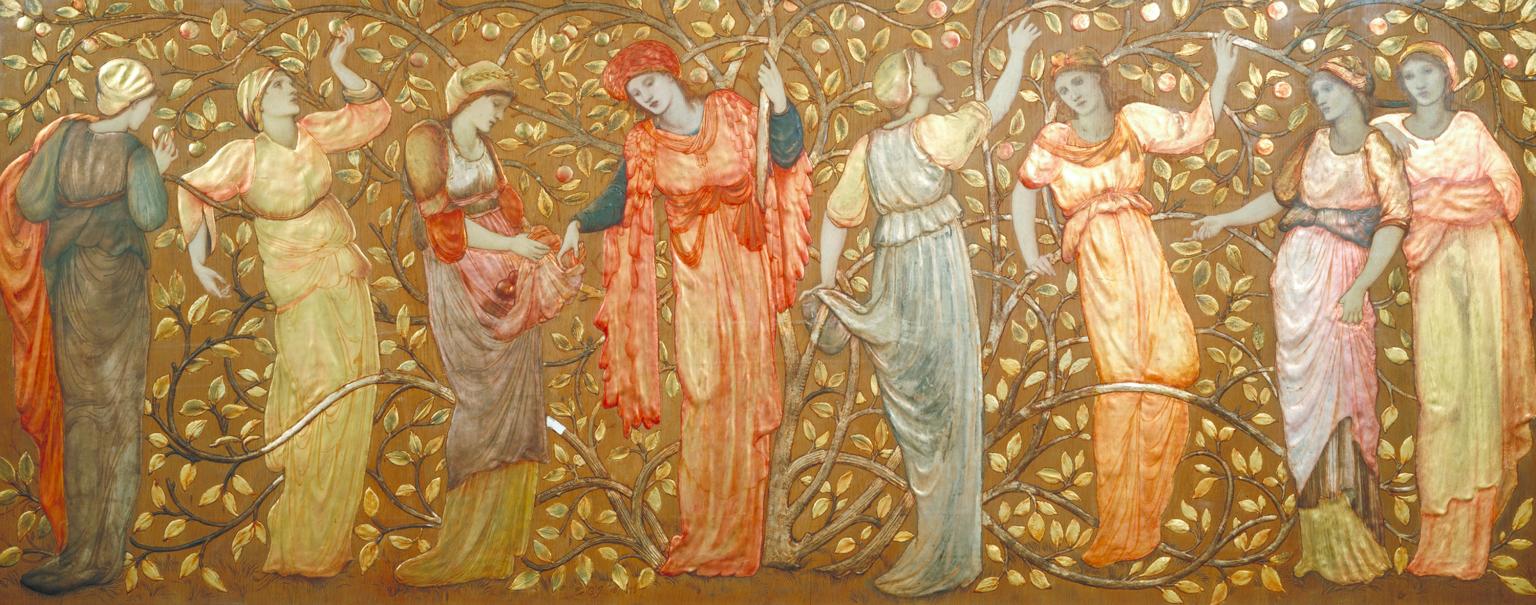
Sir Edward Coley Burne-Jones, Bt, Frieze of Eight Women Gathering Apples 1876
The theme of this panel would appear to be connected with the legend of the Garden of the Hesperides, a subject Burne-Jones treated on several other occasions. It may have been intended as an overmantel for a fireplace or as a decorative panel for a cassone or chest. The gold relief reflects the artist’s interest in early Renaissance art where such decoration was used extensively. The frieze may have been commissioned by the artist’s patron, the MP and collector William Graham, whose daughter Lady Horner owned a similar panel.
Gallery label, November 2016
1/30
artworks in Beauty as Protest
Anne Gaskell, Gaskell Wall Clock 1848
2/30
artworks in Beauty as Protest
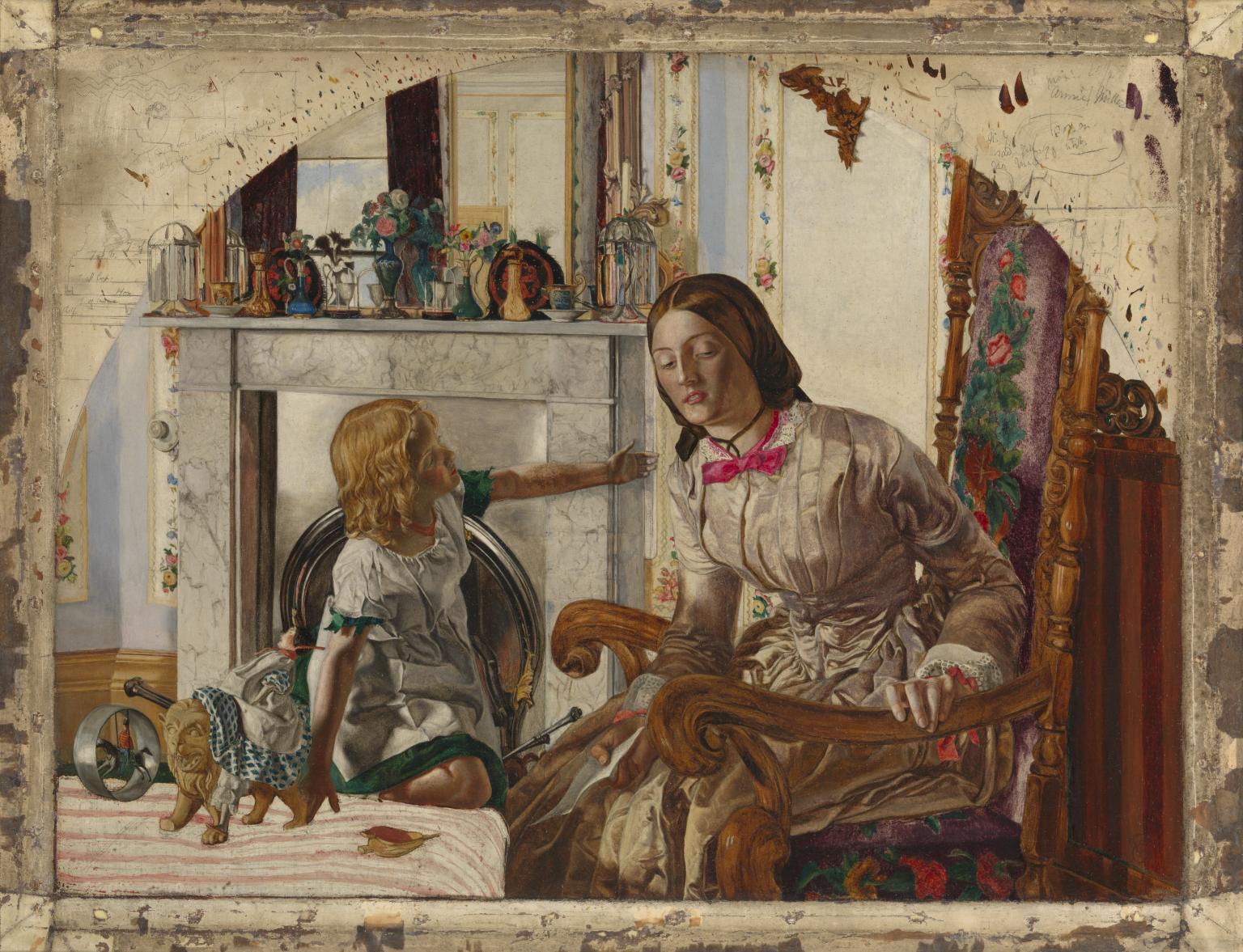
Frederic George Stephens, Mother and Child c.1854
Stephens painted this in the first year of the Crimean War (1853-6) and the major world event plays out in the setting of a Victorian nursery. The child pauses playing to reach towards his mother as she reacts to a letter which brings bad news from the conflict. Stephens encloses the figures in a curved frame like a traditional Madonna and Child and employs everyday objects, such as the military toys, as symbols. Stephen’s extremely detailed Pre-Raphaelite style was time-consuming and the picture was never finished.
Gallery label, August 2018
3/30
artworks in Beauty as Protest
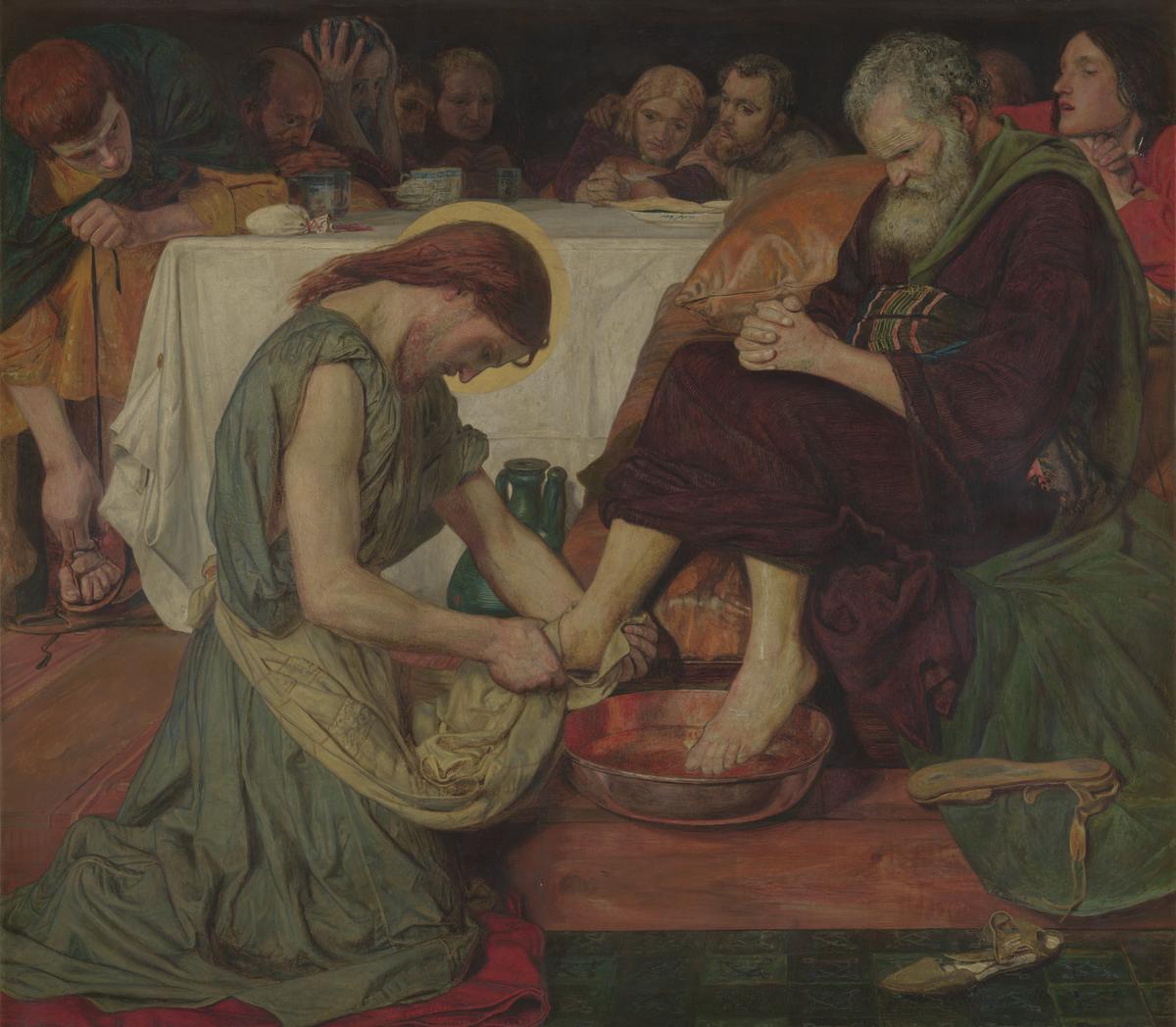
Ford Madox Brown, Jesus Washing Peter’s Feet 1852–6
This picture illustrates the biblical story of Christ washing his disciples’ feet at the Last Supper. It has an unusually low viewpoint and compressed space. Critics objected to the picture’s coarseness – it originally depicted Jesus only semi-clad. This caused an outcry when it was first exhibited and it remained unsold for several years until Ford Madox Brown reworked the figure in robes. Brown was never invited to join the Pre-Raphaelite Brotherhood but he was a close associate of the group. Several members modelled for the disciples in this picture and the critic FG Stephens sat for Christ.
Gallery label, November 2016
4/30
artworks in Beauty as Protest
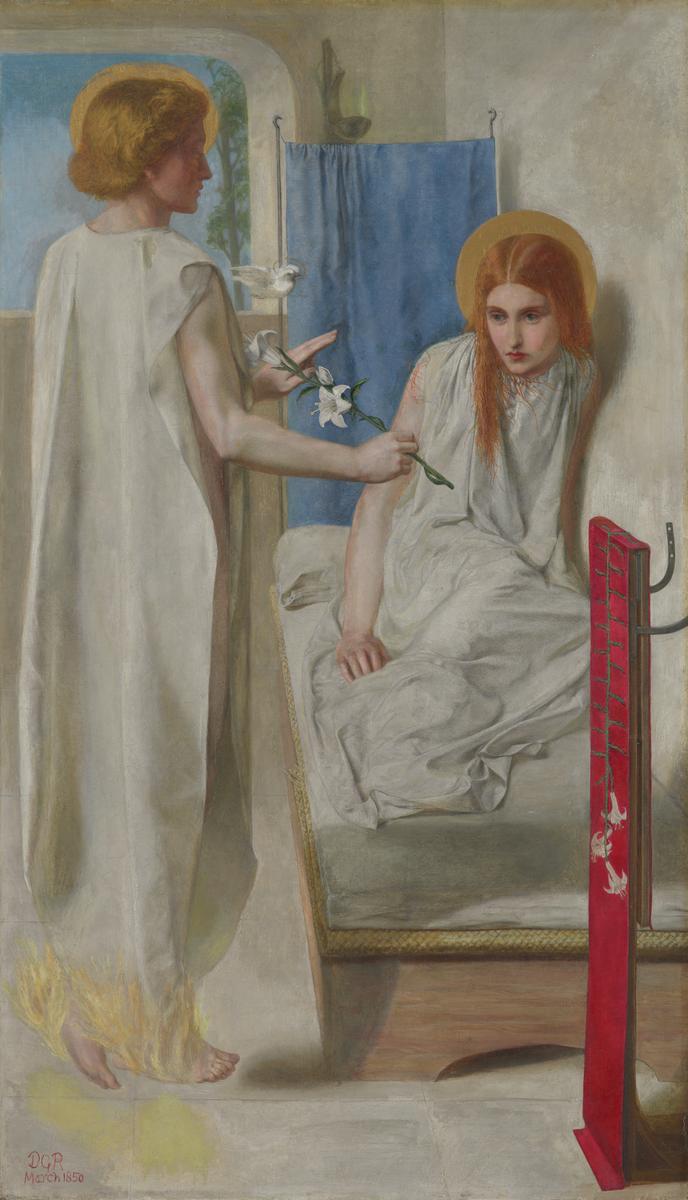
Dante Gabriel Rossetti, Ecce Ancilla Domini! (The Annunciation) 1849–50
Here, the angel Gabriel is telling the Virgin Mary that she will give birth to Jesus Christ. Dante Gabriel Rossetti portrays his sister, the poet Christina Rossetti, as Mary. Both siblings were exploring personal perspectives in their work, engaging with intimate emotions and rejecting more detached approaches. In this painting, the artist adapts medieval depictions of the Annunciation to this more modern, psychological view. Unusually, we see Mary in her bedroom where the angel has disturbed her dreams. Anxiety is suggested by the eerie colouring, her wide eyes and shrinking pose.
Gallery label, January 2025
5/30
artworks in Beauty as Protest
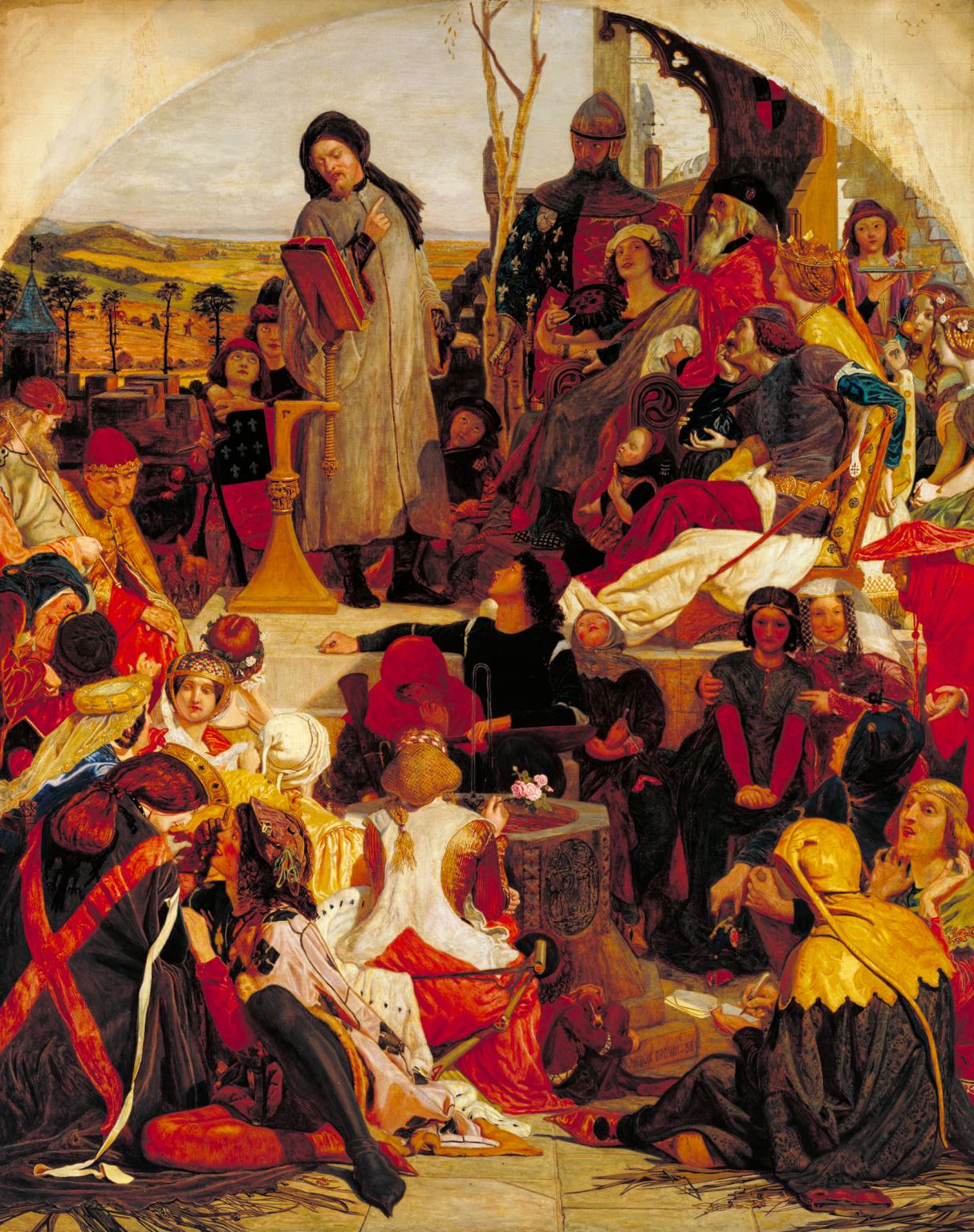
Ford Madox Brown, Chaucer at the Court of Edward III 1856–68
This picture is a replica of Ford Madox Brown’s largest and most ambitious painting, exhibited in 1851. It was significant for its portrayal of natural sunlight and was his first attempt ‘to carry out the notion ... of treating the light and shade absolutely, as it exists at any one moment, instead of approximately or in generalized style’. This pursuit of ‘truth to nature’ was consistent with Pre-Raphaelite ideals, as was his careful workmanship. The picture’s subject, Geoffrey Chaucer, reflects the growing popularity with artists of English literature instead of more conventional classical myths and biblical tales.
Gallery label, November 2016
6/30
artworks in Beauty as Protest
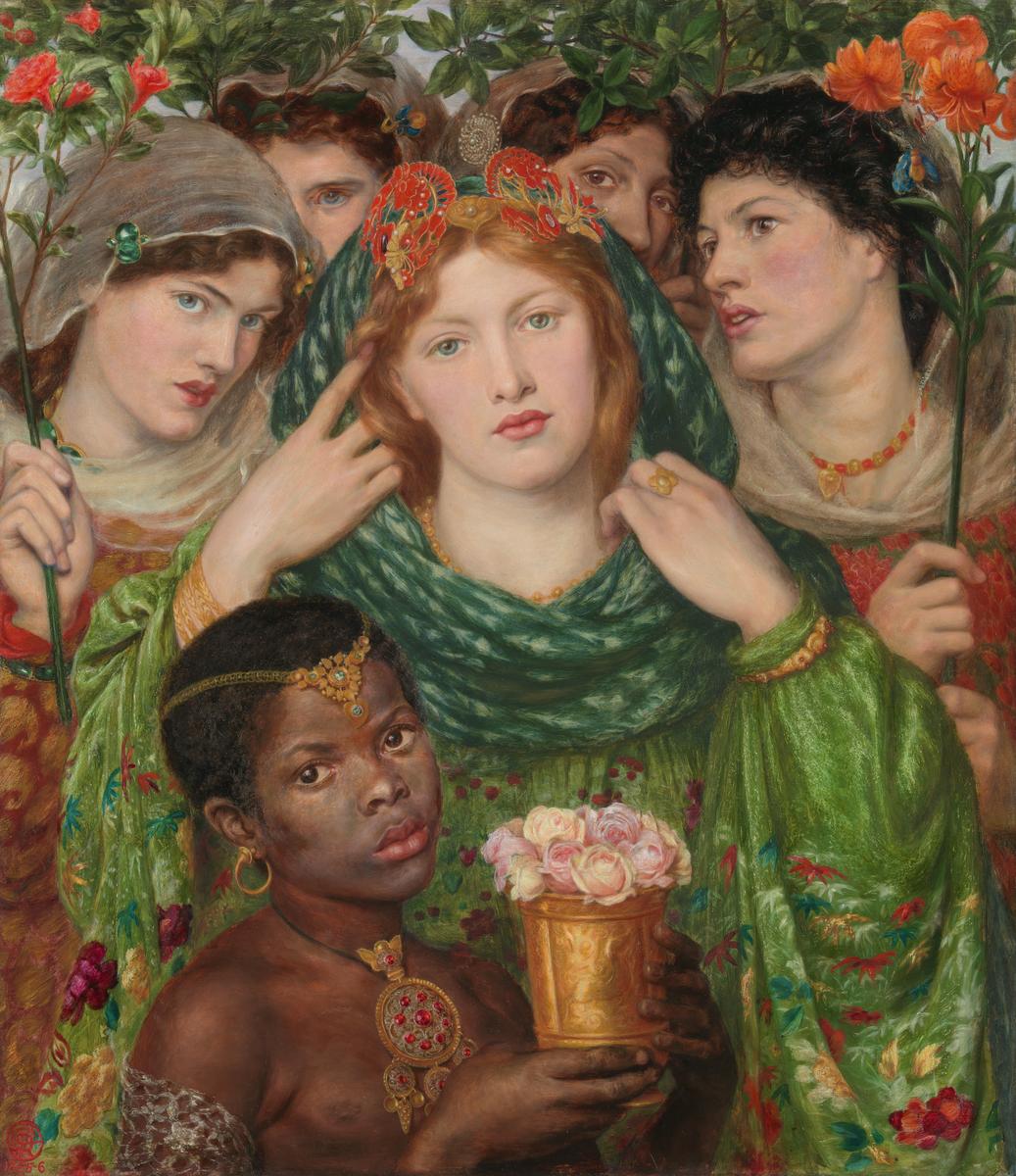
Dante Gabriel Rossetti, The Beloved (‘The Bride’) 1865–6
This painting is inspired by a biblical poem in which a bride reveals her face to her lover. The women surrounding her are modelled by Ellen Smith, an English laundress, Fanny Eaton, of Jamaican heritage, and Kiome Bonnet, of Romany descent. The young boy, whose name is unknown, was brought to London by an American around the time slavery was abolished there. Rossetti's choice of models often challenges rigid Victorian beauty ideals. Yet, the central placement of the white sitter, modelled by Mary Ford, suggests a racial hierarchy. The luxurious fabrics and jewellery from North Africa and East Asia reflect Victorian fantasies of cultures outside of Europe.
Gallery label, October 2025
7/30
artworks in Beauty as Protest
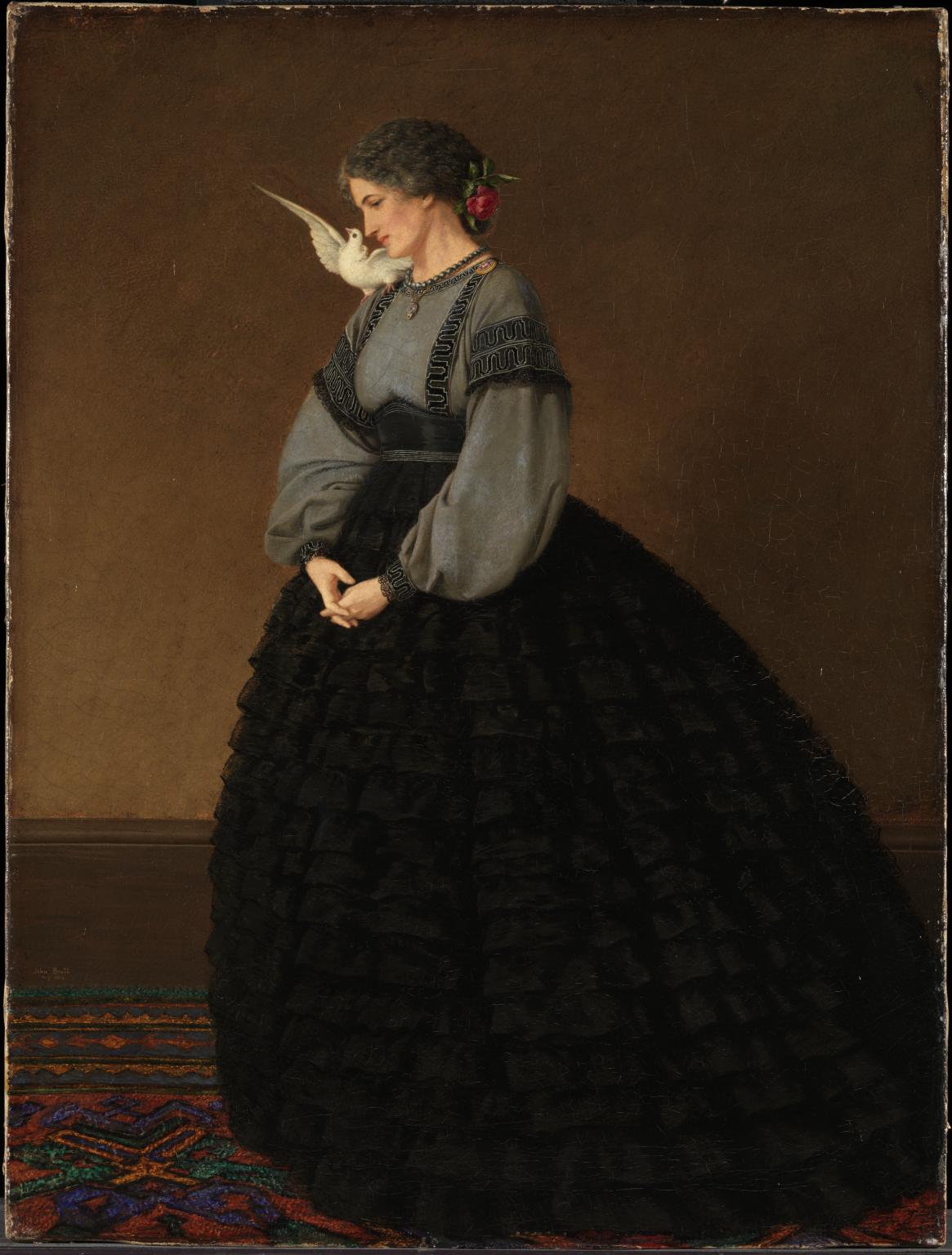
John Brett, Lady with a Dove (Madame Loeser) 1864
Jeannette Loeser, the subject of this portrait, was romantically involved with John Brett until the spring of 1865. The portrait was largely painted in Rome in the early months of 1864, and completed in London in August that year. The wing of the dove echoes the curved outline of the sitter’s skirt, and the dove motif is repeated in the mosaic brooch on her shoulder. Each corner of the frame is decorated with a winged cherub that looks into the picture as if in admiration of her beauty.
Gallery label, November 2016
8/30
artworks in Beauty as Protest

Frederic George Stephens, The Proposal (The Marquis and Griselda) c.1850
This is a scene from The Clerk’s Tale, one of Geoffrey Chaucer’s fourteenth-century Canterbury Tales. The marquis of Saluzzo has fallen in love with a poor but beautiful peasant girl, Griselda, and is proposing marriage to her. He goes on to subject her to a series of appalling trials to test her love. But Griselda is patient and eventually wins his devotion.The background of this picture was painted from life in the kitchen of the rural lodgings that Stephens shared with his friends Holman Hunt and Dante Gabriel Rossetti, at Knole in Kent.
Gallery label, July 2007
9/30
artworks in Beauty as Protest
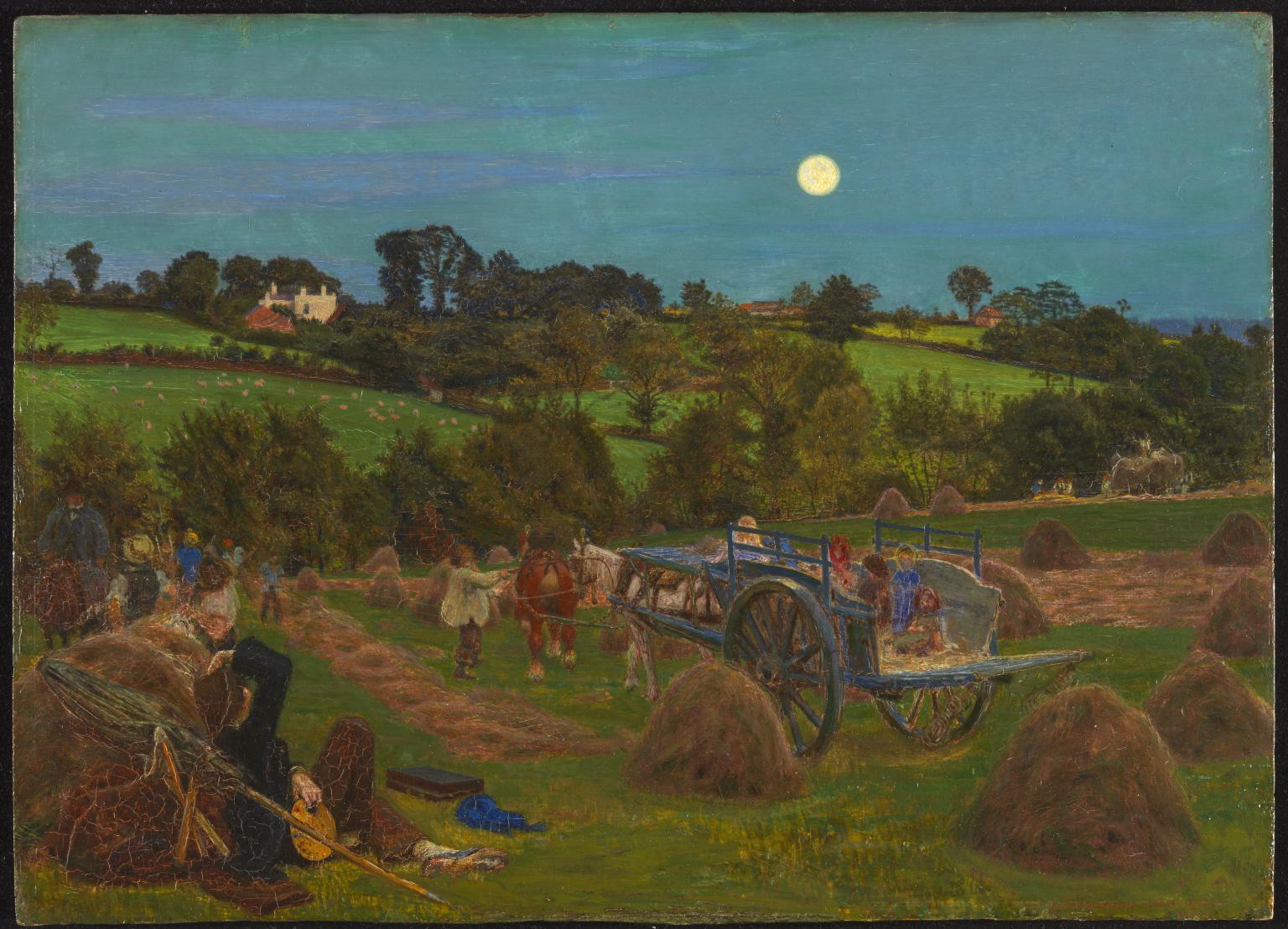
Ford Madox Brown, The Hayfield 1855–6
Brown painted this landscape directly from nature. The setting is the Tenterden estate at Hendon, north London, looking east at twilight. He finished the final details in his studio, adding a self-portrait in the lower left corner. The effect he sought to capture was the way in which the brown hay was made to appear almost pink by contrast with the dense green grass. After it was finished his dealer rejected it on the grounds that he had never seen hay of this colour. Brown later retouched the painting before selling it to his friend and fellow artist William Morris.
Gallery label, November 2016
10/30
artworks in Beauty as Protest
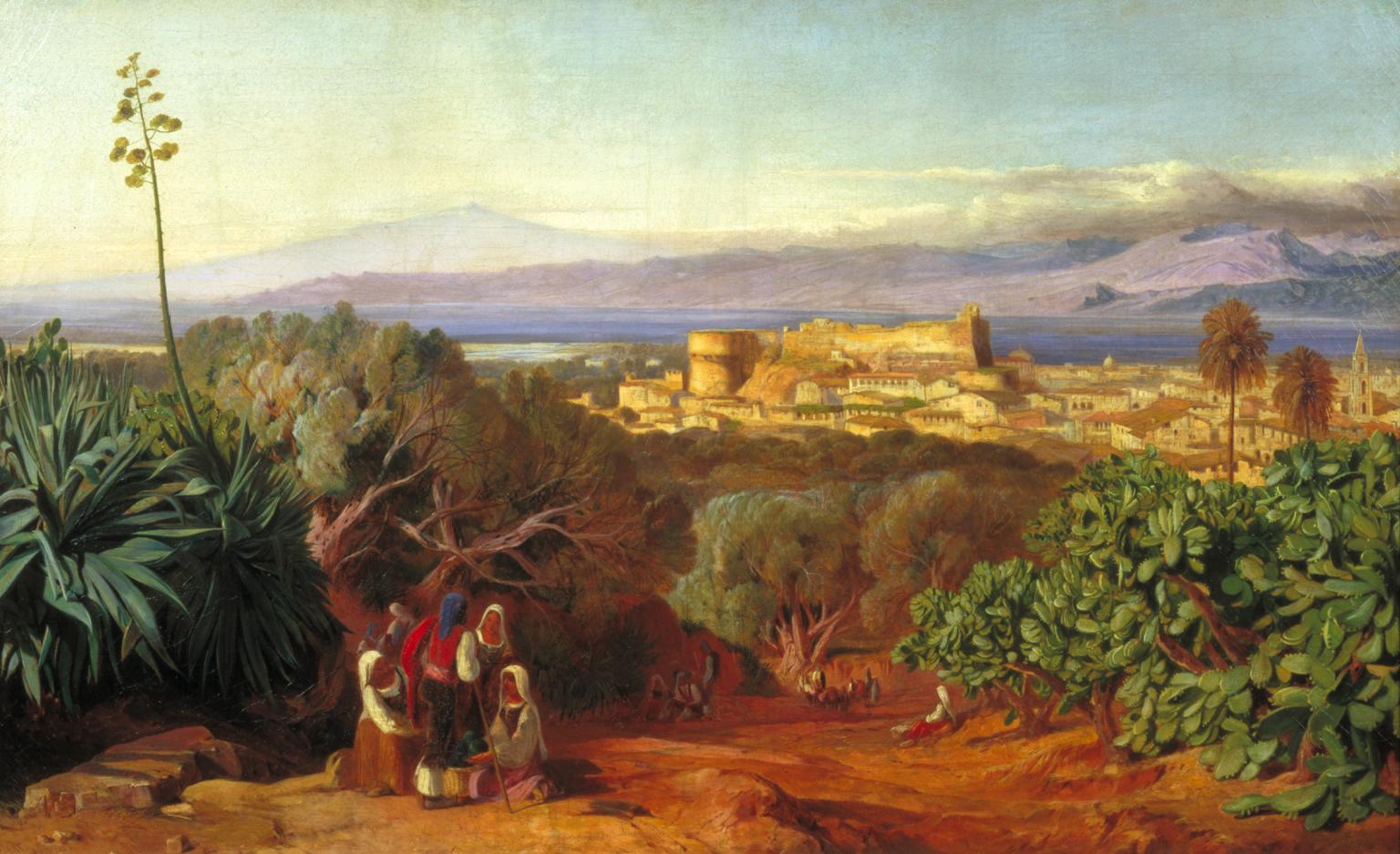
Edward Lear, View of Reggio and the Straits of Messina 1852
Edward Lear is famous for his nonsense poems but he was also a botanical and zoological illustrator and travel artist. This view of the city of Reggio Calabria in Southern Italy, looking across the water to Sicily and Mount Etna, was a well-known tourist site. Etna is famous for its frequent volcanic eruptions but Lear chose to show it at peace. He made on-the-spot studies of details including the cactus and aloe plants in 1847, and created the finished painting in London, several years later.
Gallery label, January 2025
11/30
artworks in Beauty as Protest
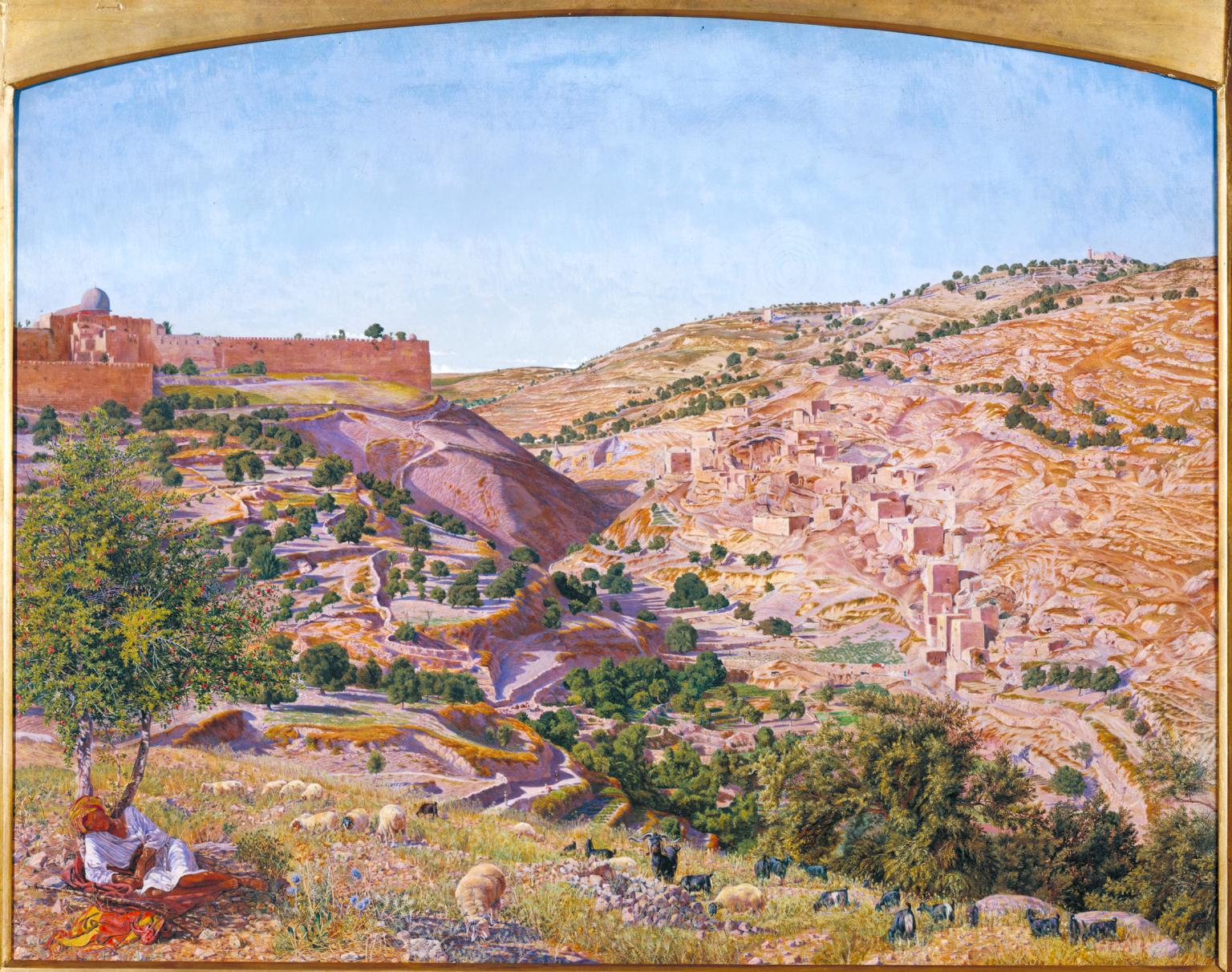
Thomas Seddon, Jerusalem and the Valley of Jehoshaphat from the Hill of Evil Counsel 1854–5
Seddon and his friend Holman Hunt journeyed to the Holy Land in 1854, to bring greater authenticity, spiritual and topographical, to their religious works. This view, painted south of Jerusalem, shows the Mount of Olives and the Garden of Gethsemane, the site of Christ’s anguish before the Crucifixion. The valley of Jehoshaphat was also believed to be where the Last Judgement would take place. Unlike John Martin’s apocalyptic visions, displayed nearby, Seddon represents the site in painstaking, sun-lit detail, paralleling the art critic John Ruskin’s remarks that ‘in following the steps of nature’, artists were ‘tracing the finger of God.’
Gallery label, March 2010
12/30
artworks in Beauty as Protest
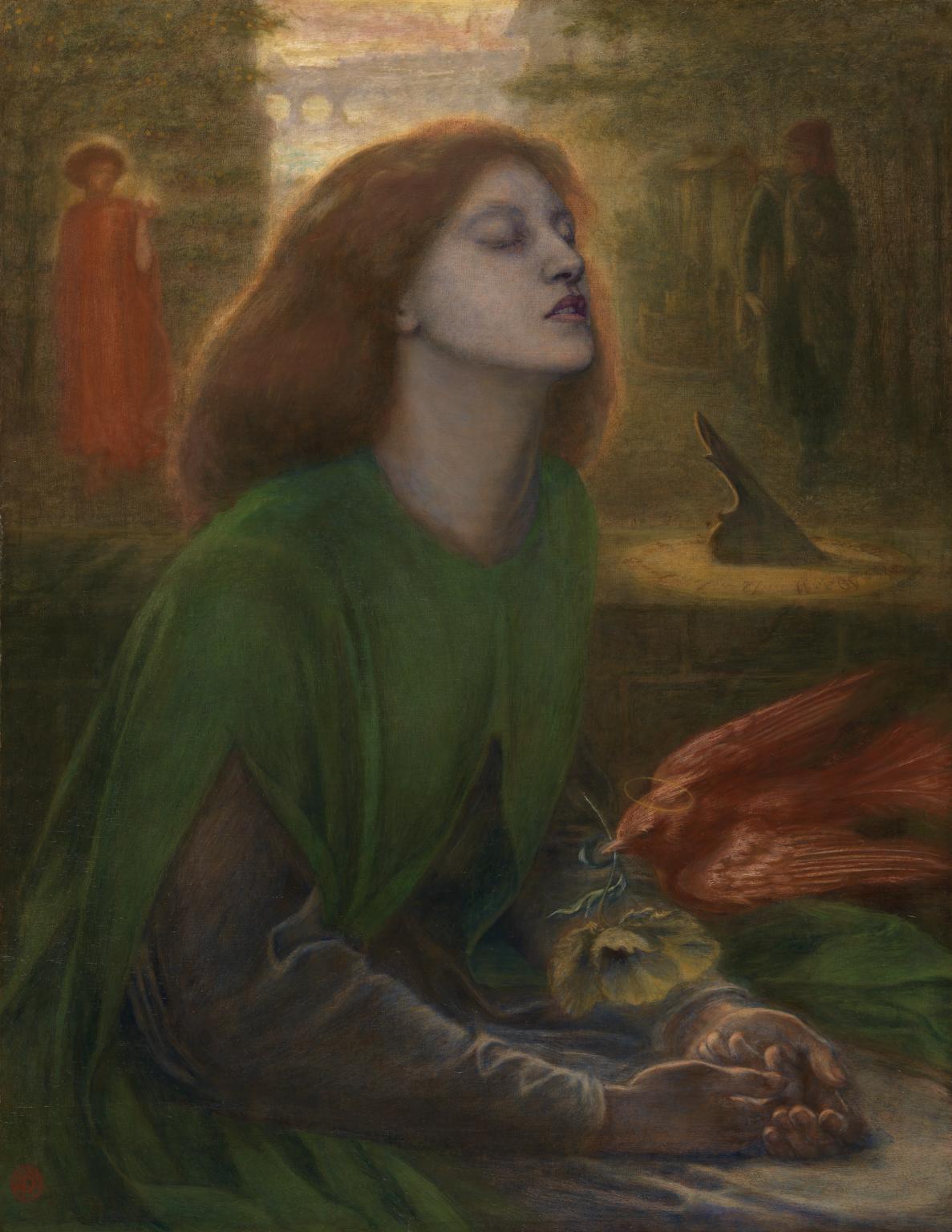
Dante Gabriel Rossetti, Beata Beatrix c.1864–70
Dante Gabriel Rossetti identified closely with the medieval poet Dante Alighieri. Rosetti saw his own despair at the death of his wife, the artist and poet Elizabeth Siddal, through Dante’s writings about the death of his beloved, Beatrice Portinari. Beata Beatrix pictures Siddal as Portinari in a dreamlike Florentine setting. Siddal’s death is re-imagined as a ‘spiritual transfiguration'. As an omen of death, a bird drops a white poppy between her open hands. In the background, Dante looks across at the figure of Love who holds the flame of life, and a sundial marks the time of her passing.
Gallery label, January 2025
13/30
artworks in Beauty as Protest
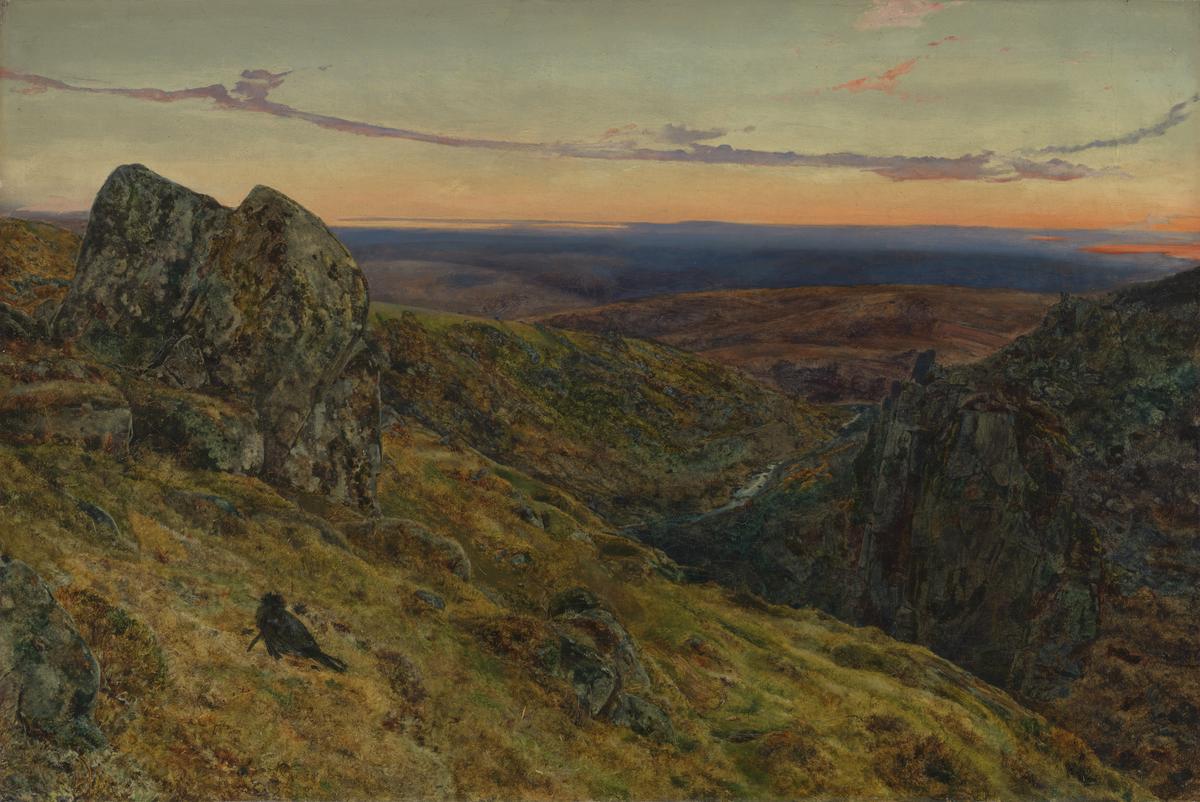
John William Inchbold, The Moorland (Dewar-stone, Dartmoor) 1854
John William Inchbold combines the Pre-Raphaelite's intense observation of detail with a mastery of light and atmosphere. He painted landscapes with literary associations. Here, he depicts the Dewerstone, a rocky area in Dartmoor National Park which features in an 1826 poem by Noel Thomas Carrington. The eerie cloud unfurling over the moor evokes the local legend of a ‘dewer’, or devil hunter, and his black dogs who were believed to drive travellers off the cliffs. The tale later inspired the Sherlock Holmes story The Hound of the Baskervilles.
Gallery label, January 2025
14/30
artworks in Beauty as Protest
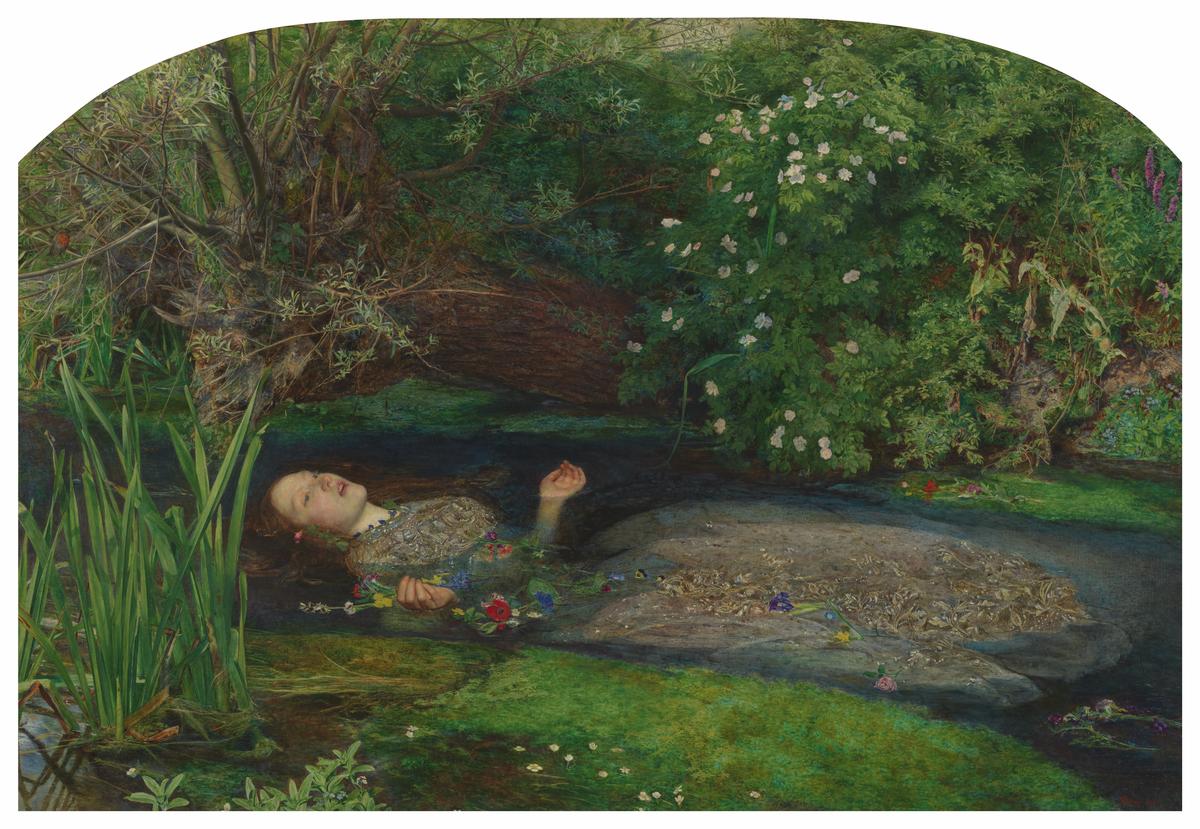
Sir John Everett Millais, Bt, Ophelia 1851–2
This work shows the death of Ophelia, a scene from Shakespeare’s play Hamlet. Traumatised when Hamlet breaks off their betrothal and accidentally kills her father, she allows herself to fall into a stream and drown. The flowers she has been collecting symbolise her story, the poppies representing death. Millais painted the lonely setting leaf-by-leaf over many months by the Hogsmill River, Surrey. Afterwards, the artist, poet and model Elizabeth Siddall posed in a wedding dress in a bath of water at Millais's studio. Through the painting, Millais critiqued the Victorian practice of occasionally arranging marriages for money and status.
Gallery label, March 2022
15/30
artworks in Beauty as Protest
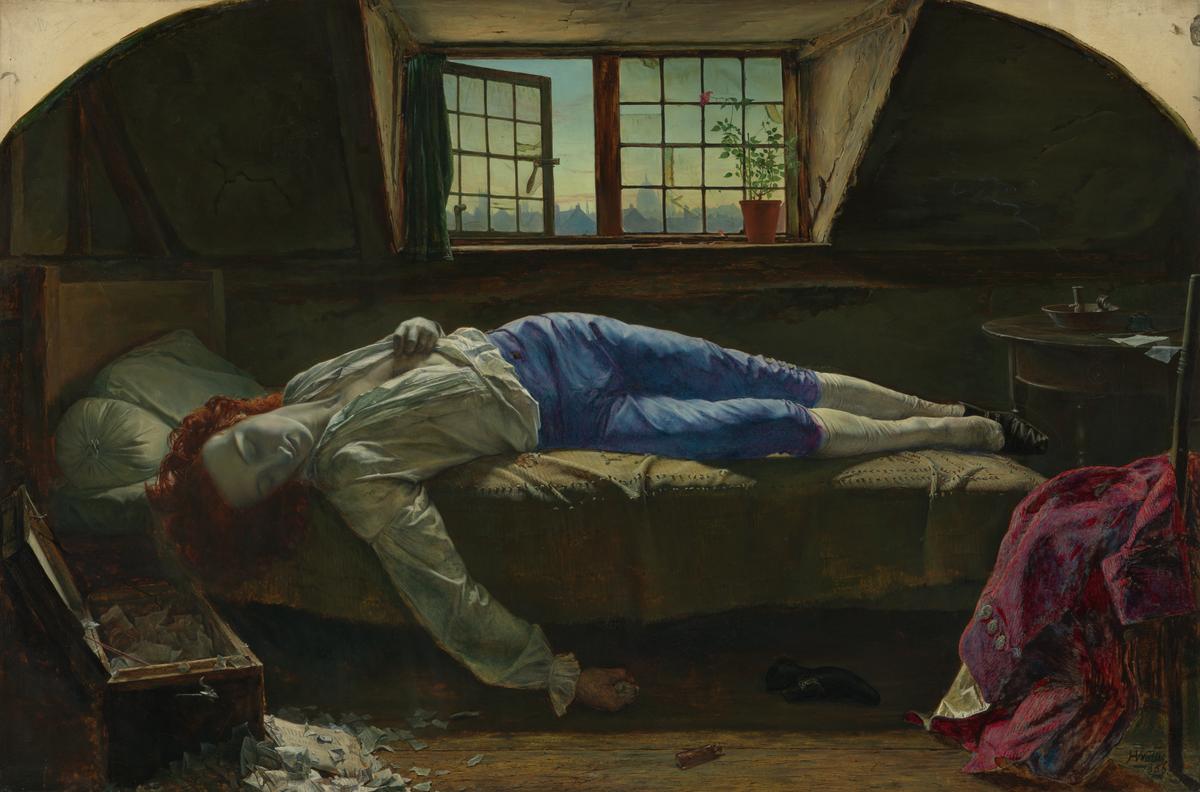
Henry Wallis, Chatterton 1856
This highly romanticised picture created a sensation when it was first exhibited at the Royal Academy in 1856. Thomas Chatterton was a poet whose ‘gothic’ writings, melancholy life and youthful suicide fascinated artists and writers of the 19th century. At an early age, he wrote fake medieval histories and poems, which he copied onto old parchment and passed off as manuscripts from the Middle Ages. The fraud was later discovered. In London he struggled to earn a living writing tales and songs for popular publications. Penniless, he took his own life by swallowing arsenic at the age of 17.
Gallery label, November 2016
16/30
artworks in Beauty as Protest
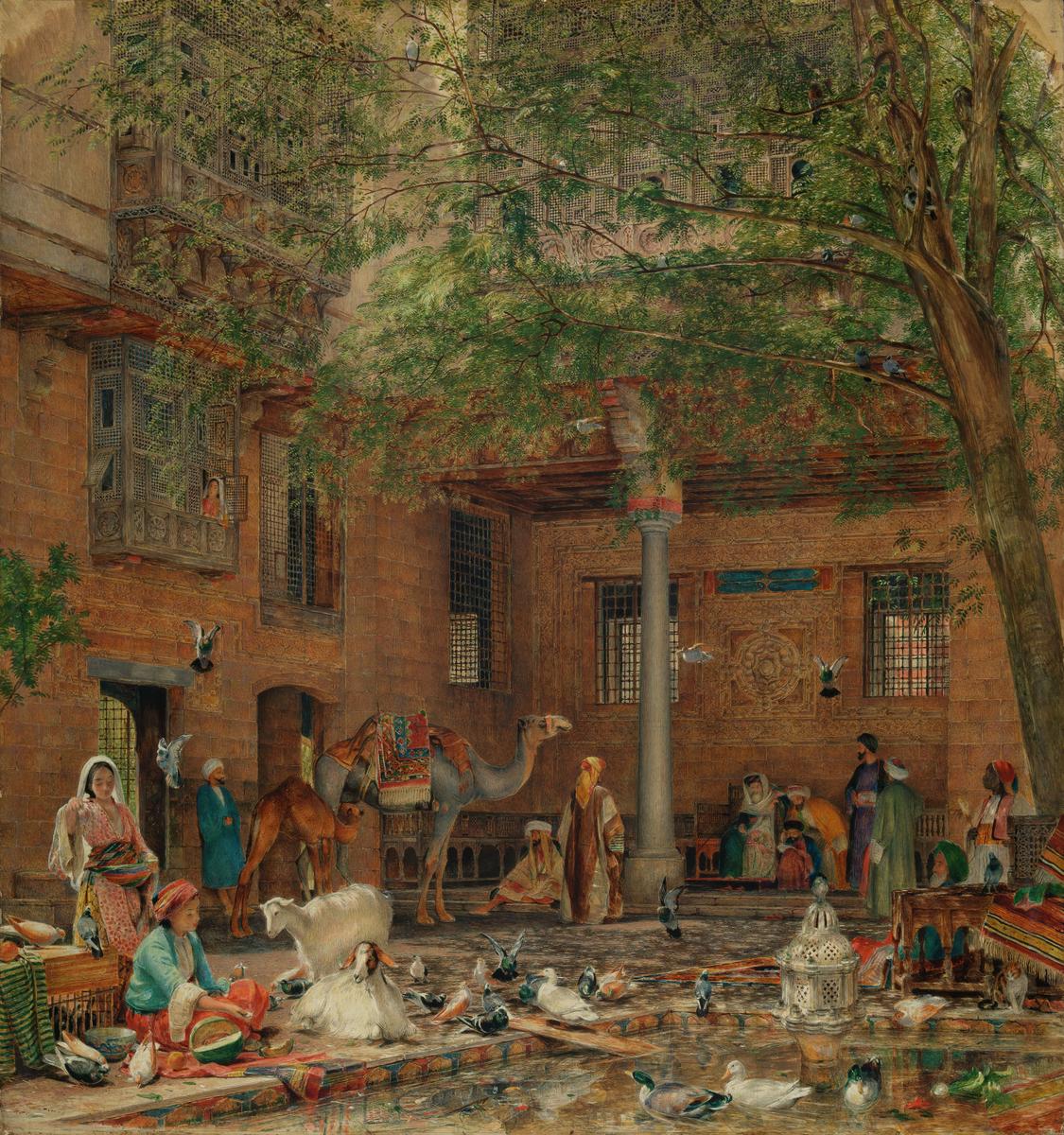
John Frederick Lewis, Study for ‘The Courtyard of the Coptic Patriarch’s House in Cairo’ c.1864
The Coptic Church is the ancient Orthodox Christian Church of Egypt. This study of the patriarch’s house was executed after Lewis’s return from Egypt in 1851, from the sketches he brought back. The picture highlights Lewis’s skill in depicting figures and setting with careful attention to light and shade, produced here by the top-lit courtyard. Lewis caused a sensation when he exhibited one of his Near Eastern scenes in London in 1850. John Ruskin admired his attention to detail, claiming that in truth-to-nature he ranked alongside the Pre-Raphaelite Brotherhood.
Gallery label, November 2016
17/30
artworks in Beauty as Protest
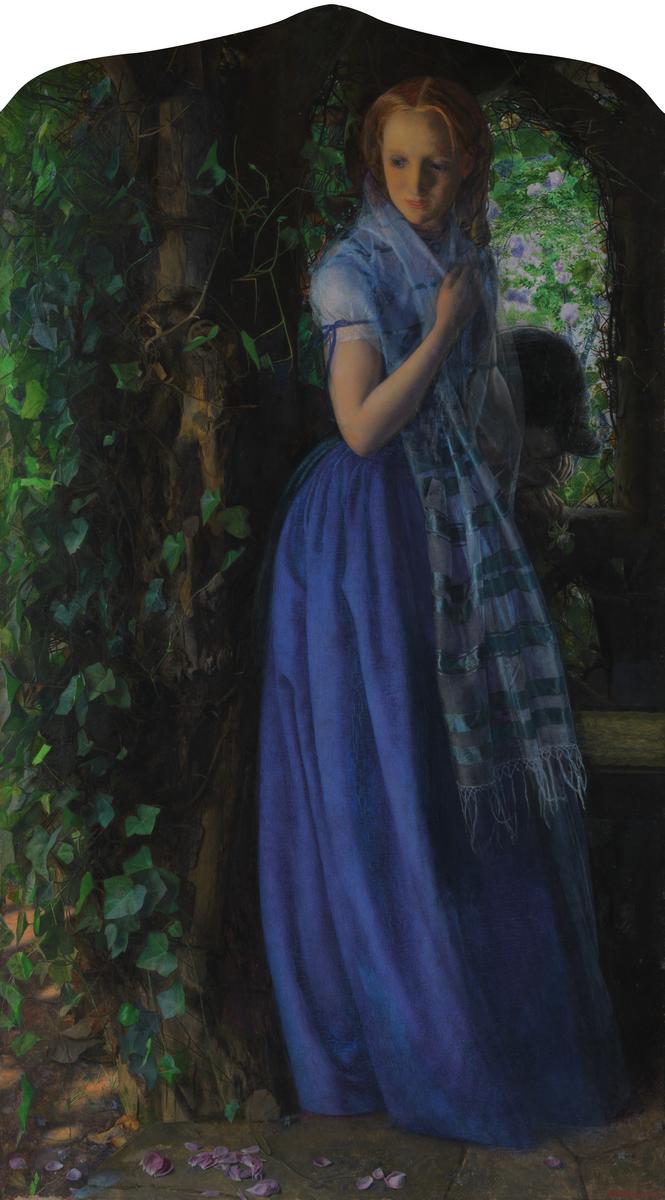
Arthur Hughes, April Love 1855–6
Arthur Hughes’s painting shows a moment of tension between a young couple. The woman turns away as the man bows his head, pressing her hand between his. The sunlit lilacs are symbols of young love but the crushed rose in the shadows on the ground suggests that the relationship is troubled. By contrast, Hughes married the model Tryphena Ford the year this picture was painted. It brought Hughes success and was purchased by William Morris.
The brilliantly coloured dress was typical of the time. New industrial dyes, factory labour and cheaper textiles enabled men and woman to dress for show.
Gallery label, January 2025
18/30
artworks in Beauty as Protest
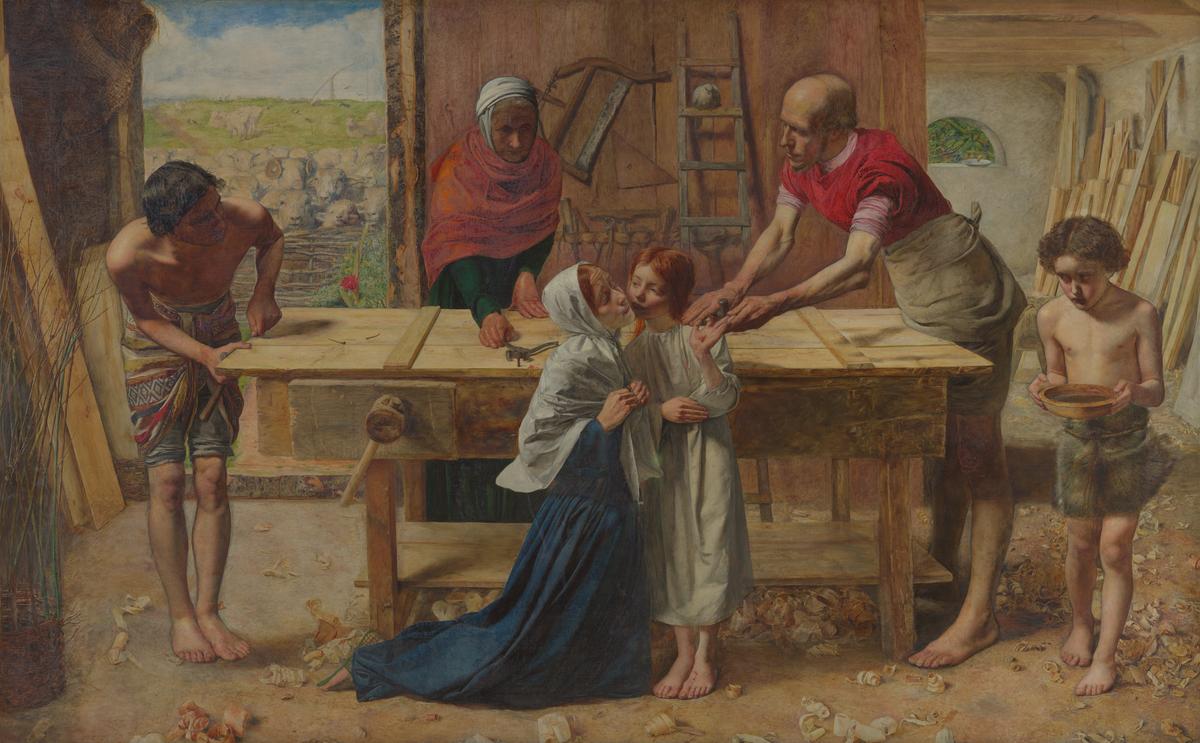
Sir John Everett Millais, Bt, Christ in the House of His Parents (‘The Carpenter’s Shop’) 1849–50
This picture was exhibited with words from the Old Testament, often seen as prefiguring Christ’s Crucifixion: ‘And one shall say unto him, What are these wounds in thine hands? Then shall he answer. Those with which I was wounded in the house of my friends.’ Millais based the setting on a real carpenter’s shop. Symbols of the Crucifixion figure prominently: the wood, the nails, the cut in Christ’s hand and the blood on his foot. Millais was viciously attacked in the press for showing the holy family as ‘ordinary’. Charles Dickens described Christ as ‘a hideous, wry-necked, blubbering, red-haired boy in a night-gown.’
Gallery label, November 2016
19/30
artworks in Beauty as Protest
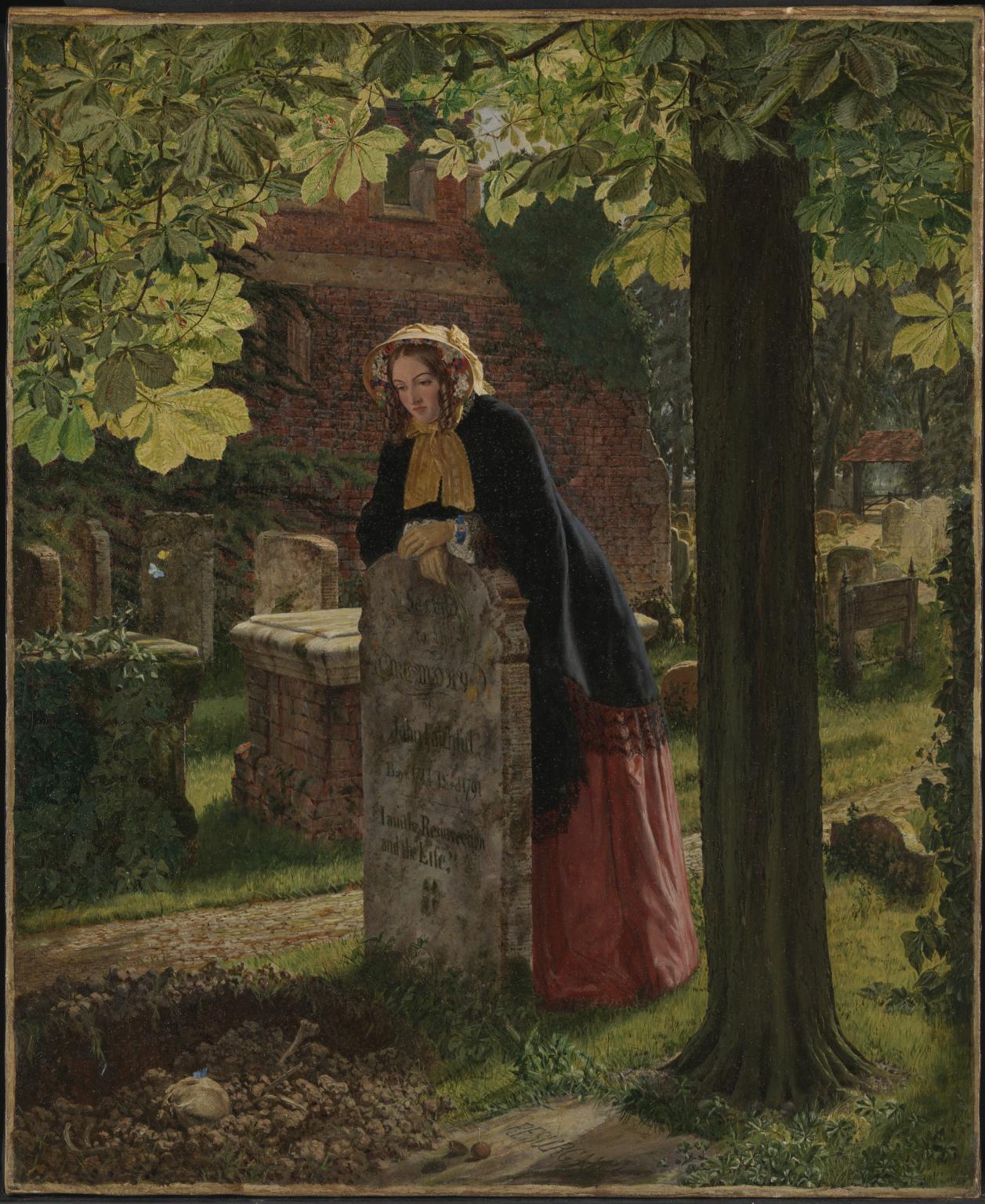
Henry Alexander Bowler, The Doubt: ‘Can these Dry Bones Live?’ exhibited 1855
This young woman, leaning on the gravestone of a man called John Faithful, is contemplating religious doubt. In particular, the Christian belief that the dead will be resurrected on the Day of Judgement. Long-standing religious beliefs were being disrupted at the time this was painted. New scientific publications explored theories of evolution, challenging literal readings of the Bible. Her question appears to be answered by the growing chestnut tree and the stone at its base, carved with the word Resurgam’, which translates as ‘I shall rise again’. The blue butterfly on the skull symbolizes the human spirit.
Gallery label, August 2018
20/30
artworks in Beauty as Protest
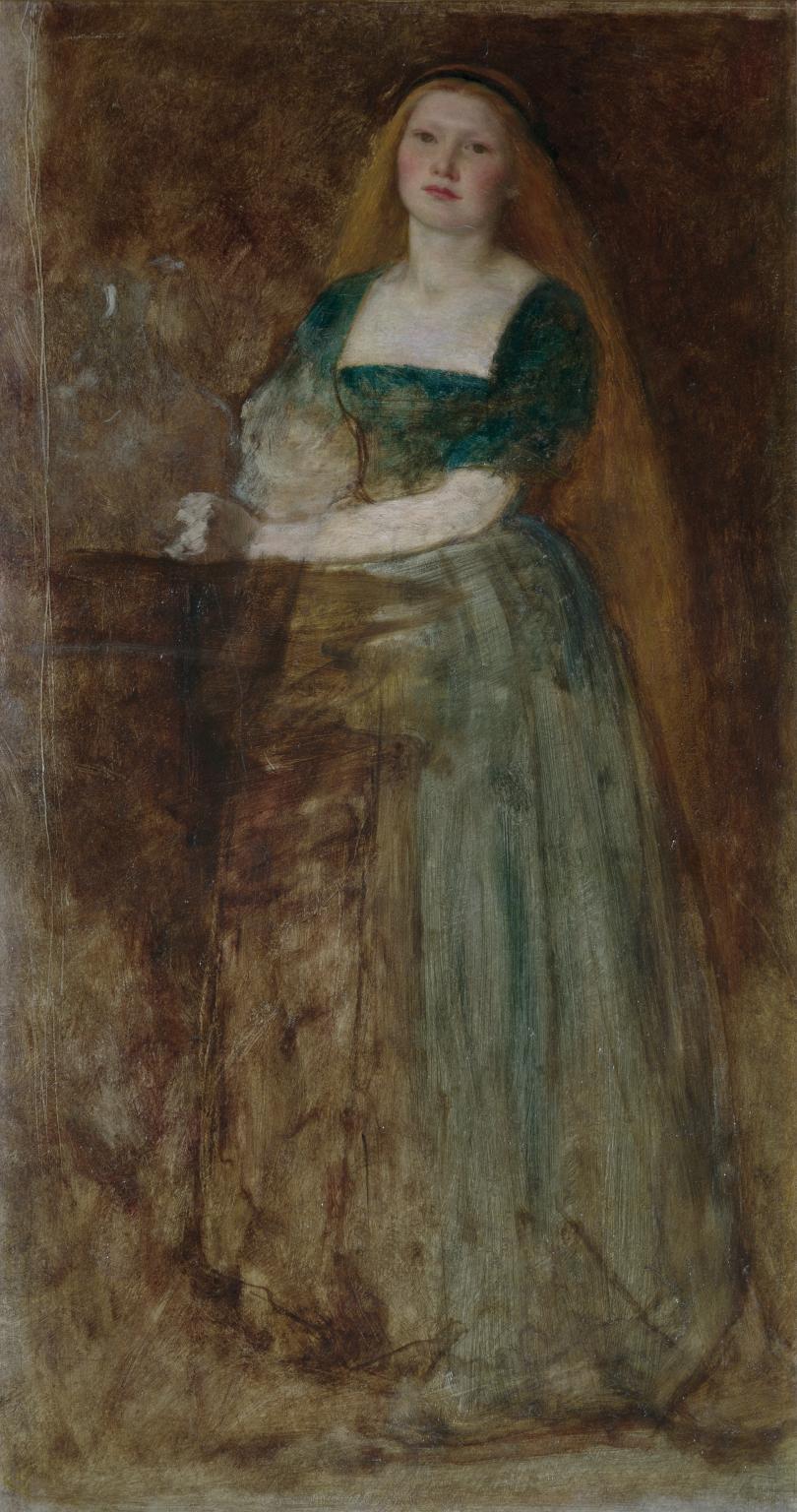
Joanna Mary Wells, Gretchen 1861
This picture alludes to a central scene in Faust, the tragic play published by German writer Johann Wolfgang von Goethe in the early 19th century. In the play, Gretchen, confused, seduced and pregnant by Faust, seeks solace in church. The sitter for the work was probably Wells’s nursery maid. Women artists had limited access to models at the time. Joanna Wells (née Boyce) had established a reputation during the 1850s as a painter of portraits, genre and landscape. She also wrote art reviews for the Saturday Review. Her career ended prematurely at the age of thirty. Wells herself was pregnant when she began this painting. She died shortly after the birth and the picture was left unfinished.
Gallery label, December 2020
21/30
artworks in Beauty as Protest
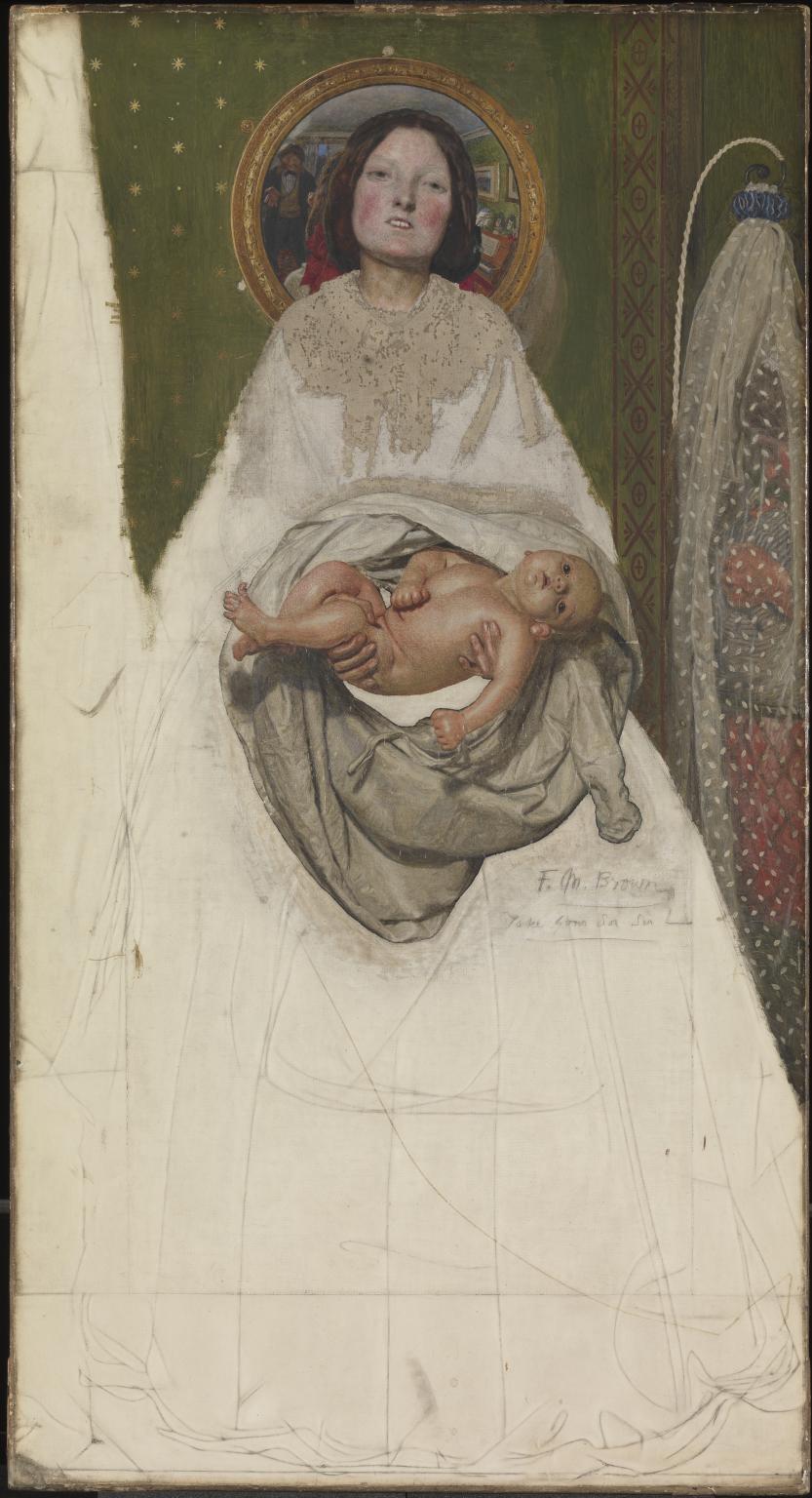
Ford Madox Brown, ‘Take your Son, Sir’ ?1851–92
This enigmatic picture shows the artist’s second wife, Emma, and their new-born son, Arthur Gabriel. The pose is reminiscent of a traditional Madonna and child but the mother’s strained expression suggests that this is not a conventional celebration of marriage and motherhood. The domestic details of the room are indicative of a contemporary-life subject in which the woman holds out the baby to her husband reflected in the mirror. Ford Madox Brown began the composition in 1851 and, although he worked on it over a number of years, abandoned it following the death of Arthur in 1857.
Gallery label, November 2016
22/30
artworks in Beauty as Protest
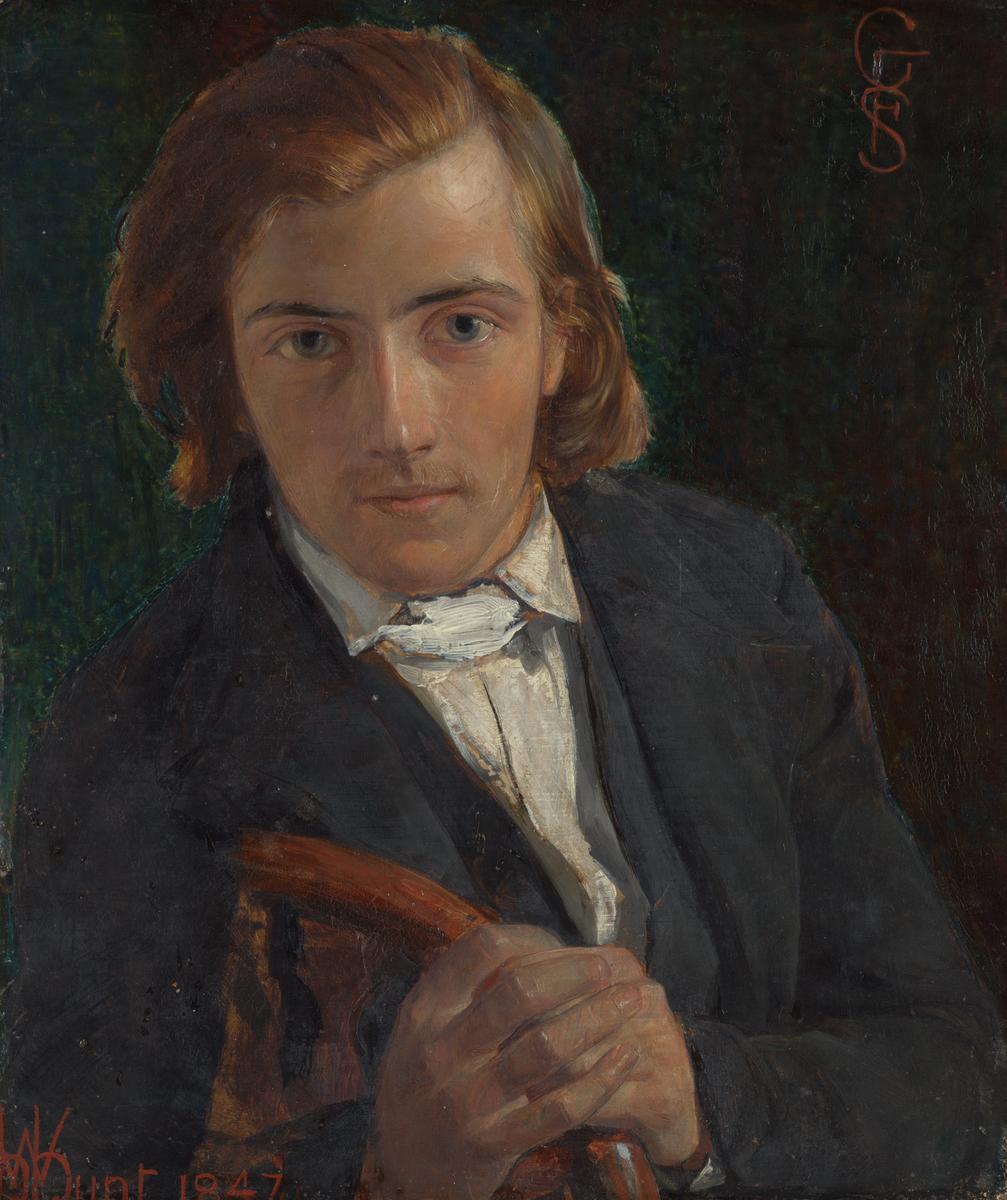
William Holman Hunt, F.G. Stephens 1847
Frederic Stephens was one of the seven original members of the Pre-Raphaelite Brotherhood. He joined the group as a painter and went on to become a leading art critic. Stephens was admired for his appearance and frequently modelled for the circle. In their early years, the Brotherhood struggled to make a living and one member, Thomas Woolner, emigrated to Australia. This picture was part of a set of portraits that the group made of each other to send to their absent friend.
Gallery label, January 2025
23/30
artworks in Beauty as Protest
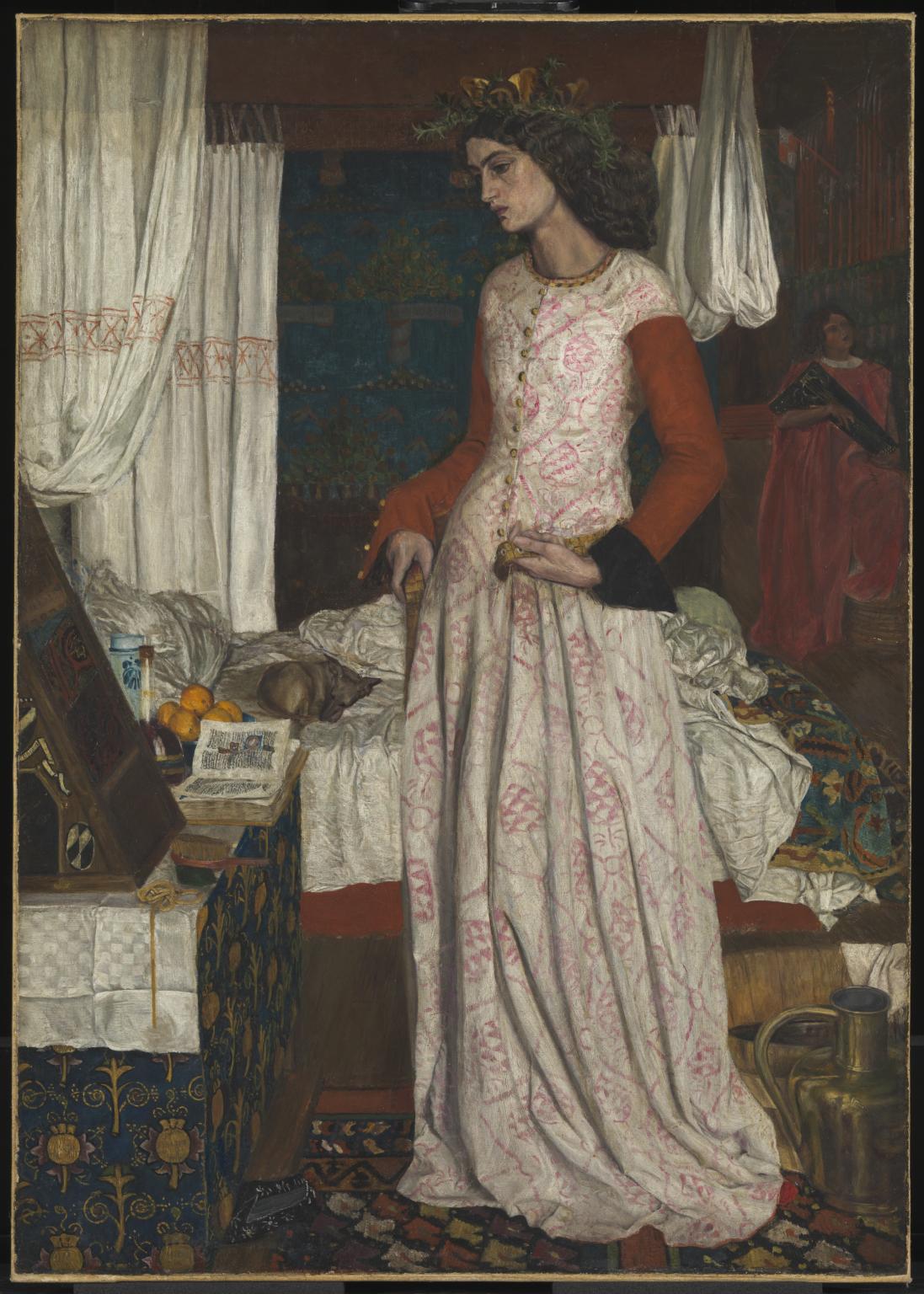
William Morris, La Belle Iseult 1858
Gallery label, August 2024
24/30
artworks in Beauty as Protest

Dante Gabriel Rossetti, Proserpine 1874
This painting captures the moment after the goddess Proserpine bites into a pomegranate. Imprisoned in the underworld, she is lit by a beam of sunlight from the world above. According to Roman legend, Hades, the God of the Underworld, stole and imprisoned Proserpine. Because she ate six pomegranate seeds while captive, he curses her to remain in the underworld for six months of every year. The model was Dante Gabriel Rossetti’s friend Jane Morris, whom he painted repeatedly in his later years. He was working on an eighth version of Proserpine in the month of his death.
Gallery label, January 2025
25/30
artworks in Beauty as Protest

William Holman Hunt, Our English Coasts, 1852 (‘Strayed Sheep’) 1852
The location shown in this painting is the Lovers’ Seat, an idyllic spot at Fairlight Glen near Hastings in Sussex. Hunt laboured here from mid-August to December 1852, enduring rain, wind and bitter cold to master his view. Despite the changes in weather, the painting seems a credible replication of particular illuminated moment. The colours used to convey light are daringly juxtaposed in order to intensify the clarity of every surface, a method that astounded audiences on both sides of the Channel.
Gallery label, November 2016
26/30
artworks in Beauty as Protest
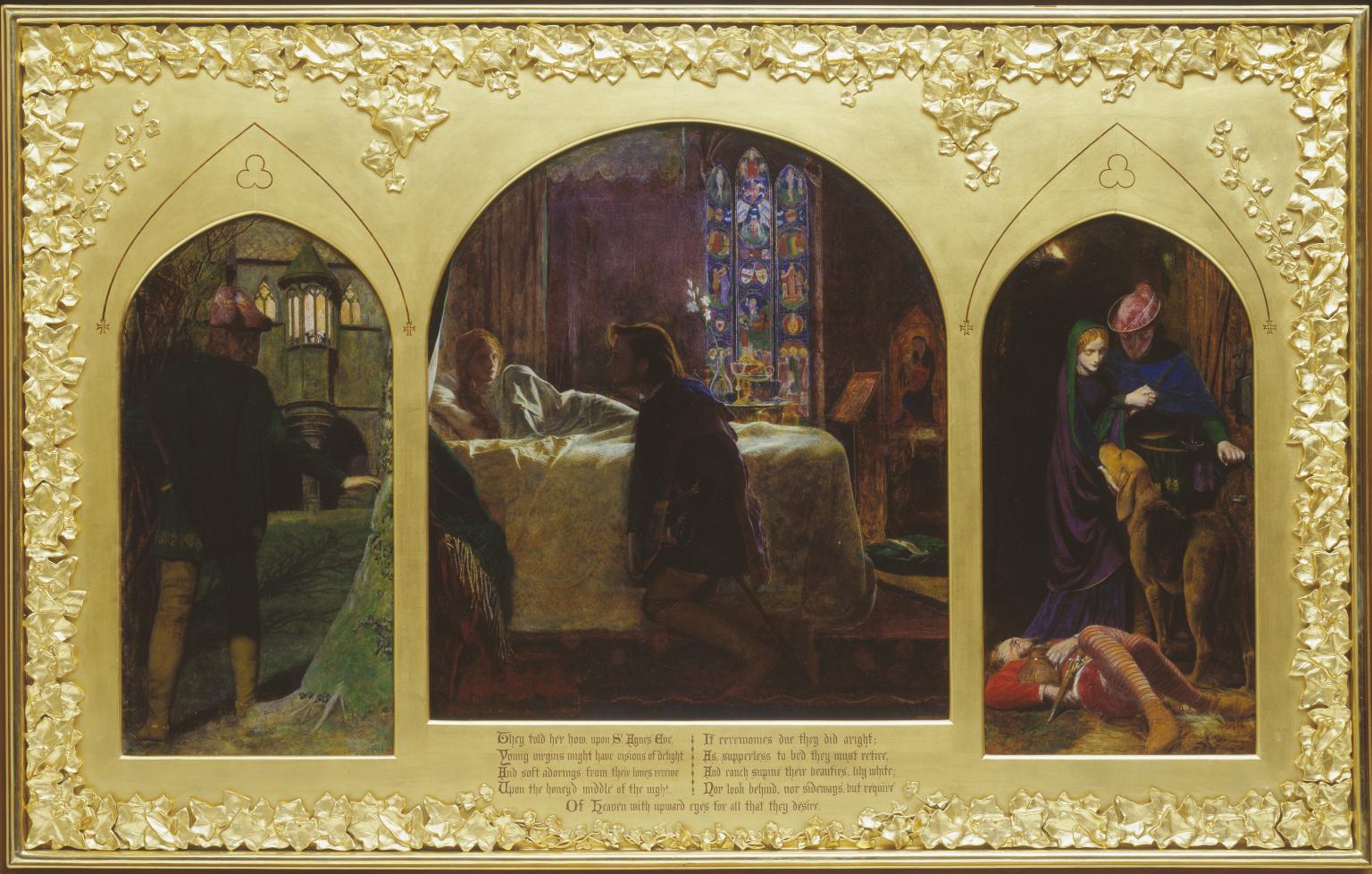
Arthur Hughes, The Eve of St Agnes 1856
This work was based on John Keats's poem The Eve of St Agnes (1820), inspired by the folk belief that a woman can see her future husband in a dream if she performs certain rites the day before the feast of St. Agnes, the patron saint of virgins. The frame is inscribed with the fourth verse of the poem, which sets the scene for the three episodes which Hughes depicts. First, Porphyro defies Madeleine’s family to approach the castle, where a banquet is in progress. He then awakens Madeline from her dreams. Finally, the lovers silently escape from the dark castle into the night.
Gallery label, March 2022
27/30
artworks in Beauty as Protest
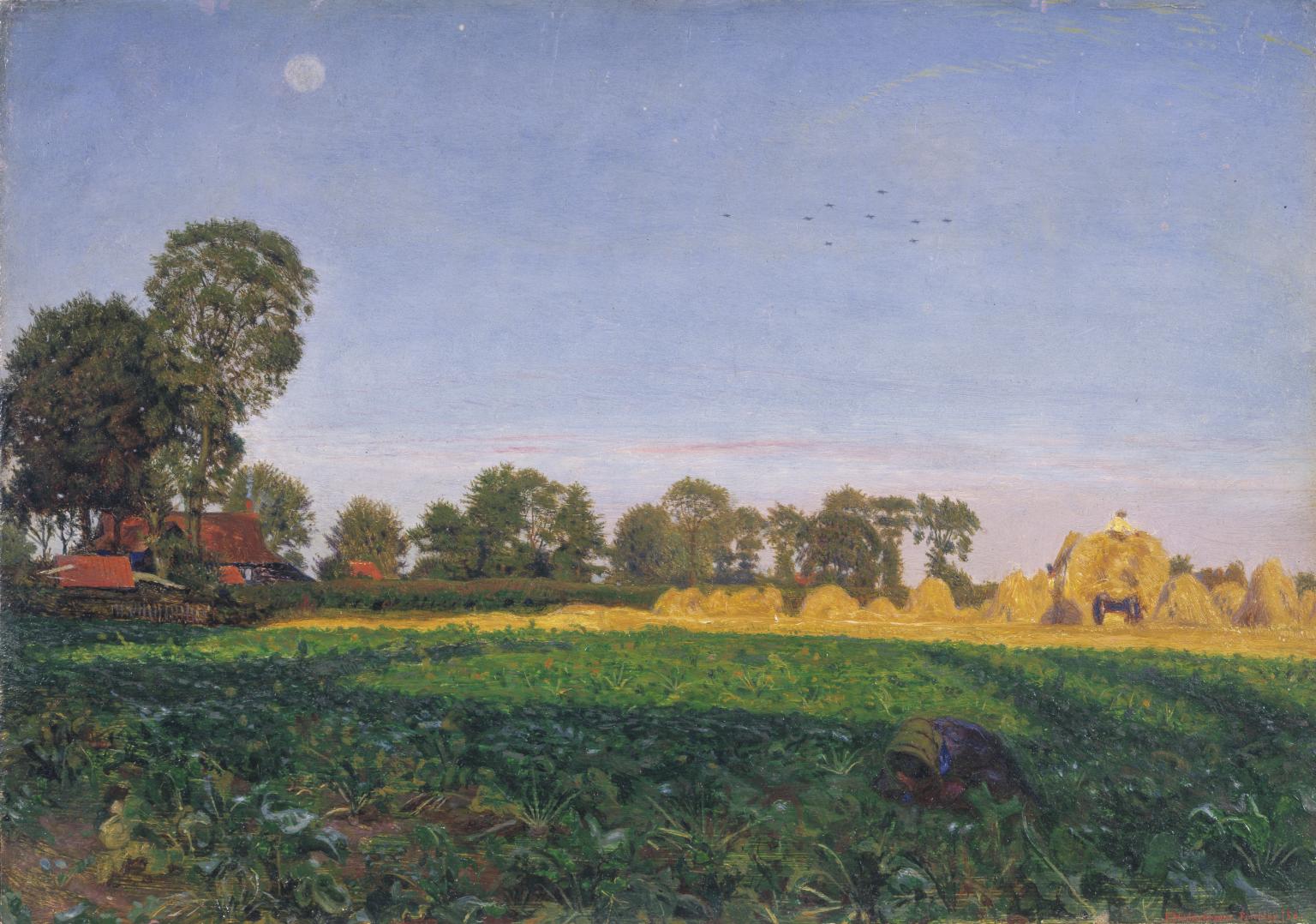
Ford Madox Brown, Carrying Corn 1854–5
This intensely coloured painting captures a harvest field just before sunset. Each landscape element is faithfully recorded in jewel-like colours. This is a nostalgic view of rural England, untouched by industrialisation and modern city life. Ford Madox Brown’s view is typical of idealists of the time who believed that an engagement with nature offered spiritual redemption from urban corruption. Brown and his family were facing financial hardship at the time this picture was painted. It was one of a number of ‘potboilers’, modest and straightforward landscapes he hoped would sell easily.
Gallery label, July 2007
28/30
artworks in Beauty as Protest
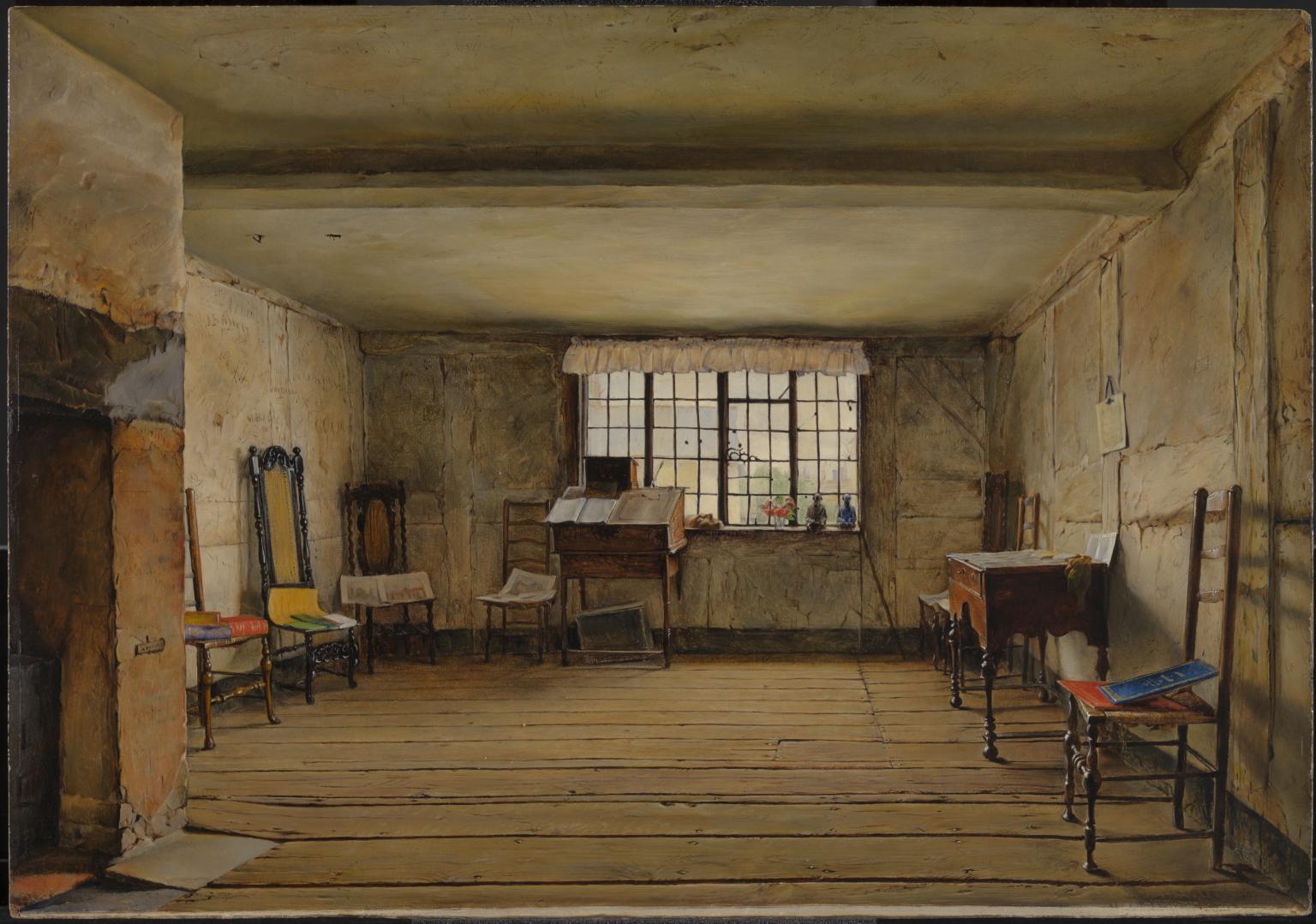
Henry Wallis, The Room in Which Shakespeare Was Born 1853
Wallis launched his career exhibiting a sequence of paintings of interior scenes connected with the life of playwright William Shakespeare (1564-1616). This one shows Shakespeare’s birthplace in Stratford-upon-Avon. It is based on a biography by Charles Knight written in 1842. It describes ‘the mean room, with its massive joists and plastered walls, firm with ribs of oak’. Wallis has painted the room in detail, including every nail securing the floorboards. He has also taken note of Knight’s passage describing how ‘hundreds amongst the hundreds of thousands by whom that name is honoured have inscribed their names on the walls of the room.’
Gallery label, June 2019
29/30
artworks in Beauty as Protest
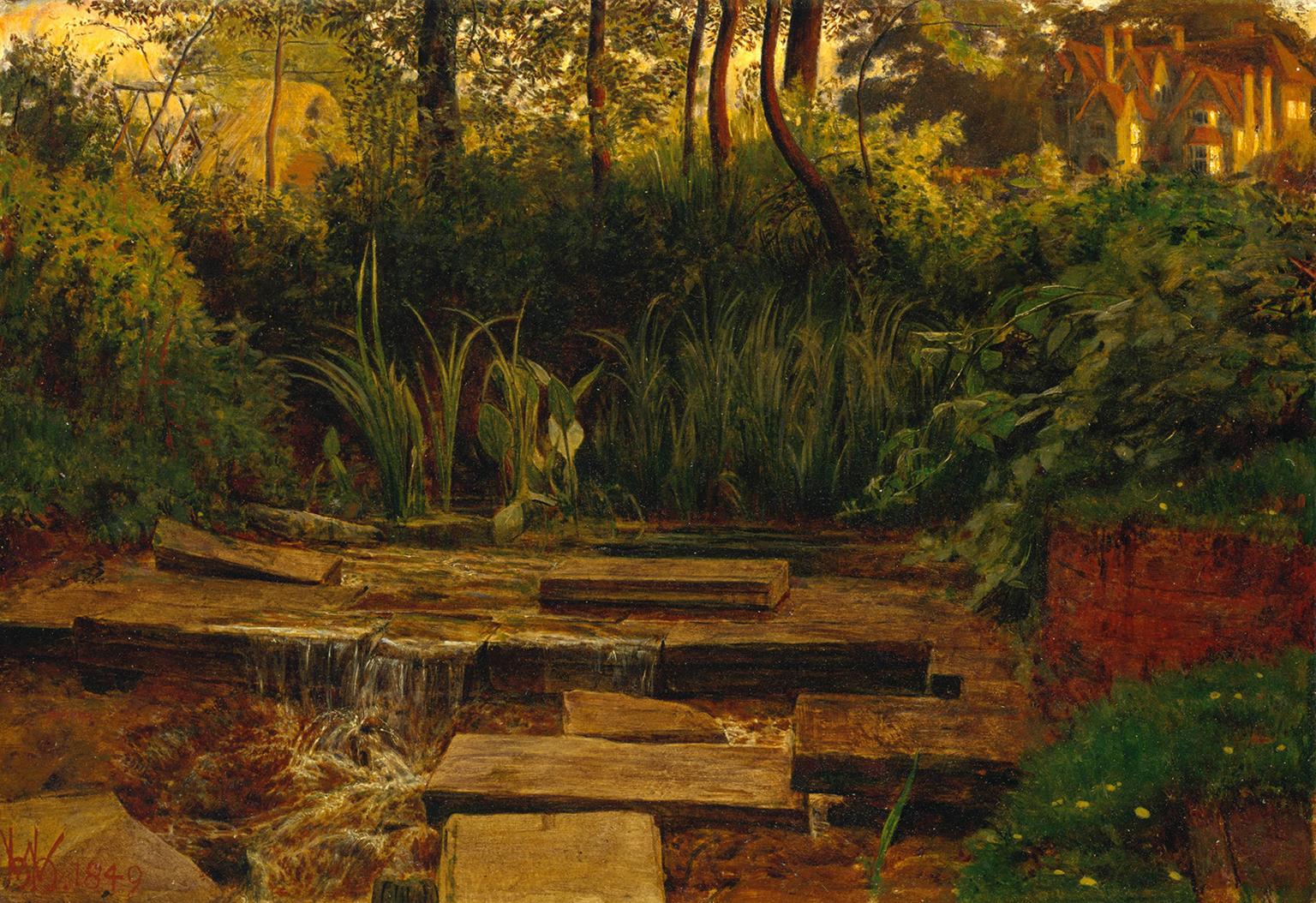
William Holman Hunt, The Haunted Manor 1849
Most of this landscape was painted in the open air in Wimbledon Park, in south-west London. The Pre-Raphaelite Brotherhood believed strongly in painting directly from nature.The picture has a low view point, filled with close and fastidious studies of plants, rocks and water. The murky tones of the waterfall and tangled vegetation contrast strongly with the narrow, brightly-lit strip of landscape at the top of the picture. It is likely that this and the deserted manor house in the top right were added later, to give the scene a mysterious atmosphere.
Gallery label, July 2007
30/30
artworks in Beauty as Protest
Art in this room

Sorry, no image available




























You've viewed 6/30 artworks
You've viewed 30/30 artworks
